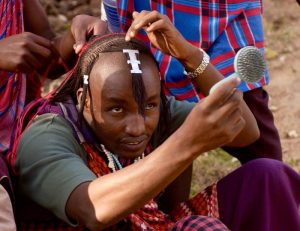Hair Styles and Head-Gears
by Sr. Mairead O’Quigley MMM (1917 – 2003) Ireland/Tanzania 13.08.2025
First published by MMM in 1956
 “Women and their hair styles!” But what about the men?
“Women and their hair styles!” But what about the men?
The story goes that in the life of St. Hugh of Lincoln there was a young sacristan named Martin. He wore his beautiful hair floating on his shoulders, as was the fashion. It was the rule in those days for sacristans to wear their hair short like the clerics, but Martin could not make up his mid to part with his curls. Twice the bishop told him to cut his hair, but he still neglected to do so. Then one day the bishop said, “Since you cannot get a barber, I will cut your hair myself!”. As the bishop was cutting his hair, Martin told him that it was the only thing keeping him back from giving himself to God.
Among the tribes of East Africa today the men as well as the women specialise in hair styles. Each tribe has its own distinguishing head-dress, whether it be made from pieces of cowskin, the horns of a rhino, or the coat of a zebra or leopard. But of all the tribes of Tanganyika (Tanzania) perhaps the warrior tribe of the Maasai attracts most attention by its hair style.
A lot of time and thought goes into the coiffure ad many an odd thing too. Custom prescribes the following ingredients: a piece of straight stick, about twelve inches long for each pigtail, a strip of the inner skin of a sheep, one inch wide, several feet of fine string made from ox-gut, cord made from the roots of a tree, and sheep fat, red ochre, and ornaments.
The hair at the back of the head is twisted into braided strands which are then grouped around the end of the stick and lashed on with the gut string. The stick and the hair ends are then bound neatly with the sheepskin strip so as to taper into a point. The hair in front is divided into three equal parts and braided, the ends of each part being bound together with gut string. The two side pieces which fall to the front of the ears, are then tied together with a chord under the chin and so held fast against the face. The centre forelock is finished off with a metal clasp. The whole coiffure is then liberally coated with fat and tinted with red ochre.
The Maaai women? They wear their hair cut close to the head, no style at all, thus emphasising that to have one’s locks formally braided is an initiation to manhood.
SEE ALL BLOG POSTS
